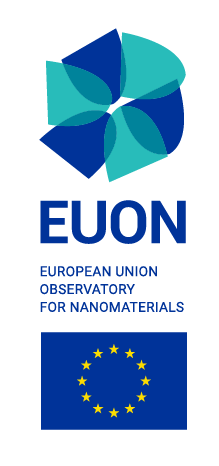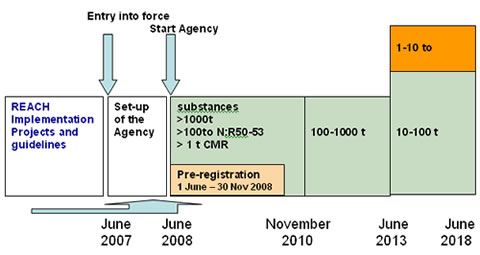|
European Union Observatory For Nanomaterials
The European Union Observatory for Nanomaterials (EUON) is an initiative that aims to increase the transparency and availability of information on nanomaterials to the general public. It was launched in June 2017. The EUON collects existing information from databases, registries and studies and generates new data through additional studies and surveys on nanomaterials on the EU market. The EUON website has content in 23 EU languages covering uses, safety, regulation, international activities as well as research and innovation. It has been set-up, managed and maintained by the European Chemicals Agency (ECHA). Establishment The EUON is the result of a perceived lack of necessary information about existing nanomaterials on the EU market. Against this background the European Commission conducted an impact assessment on different solutions to address the perception and increase the transparency of information. The European Commission also committed to address the issue of transp ... [...More Info...] [...Related Items...] OR: [Wikipedia] [Google] [Baidu] |
Nanomaterials
Nanomaterials describe, in principle, chemical substances or materials of which a single unit is sized (in at least one dimension) between 1 and 100 nm (the usual definition of nanoscale). Nanomaterials research takes a materials science-based approach to nanotechnology, leveraging advances in materials metrology and synthesis which have been developed in support of microfabrication research. Materials with structure at the nanoscale often have unique optical, electronic, thermo-physical or mechanical properties. Nanomaterials are slowly becoming commercialized and beginning to emerge as commodities. Definition In ISO/TS 80004, ''nanomaterial'' is defined as the "material with any external dimension in the nanoscale or having internal structure or surface structure in the nanoscale", with ''nanoscale'' defined as the "length range approximately from 1 nm to 100 nm". This includes both ''nano-objects'', which are discrete pieces of material, and ''nanostructu ... [...More Info...] [...Related Items...] OR: [Wikipedia] [Google] [Baidu] |
Nanotechnology Industries Association
The Nanotechnology Industries Association (NIA) is the sector-independent expert, membership and advocacy organisation providing a responsible voice for the industrial nanotechnologies supply chains. The NIA works with regulators and stakeholders on the national, European and international levels so as to secure a supportive environment for the continuing advancement and establishment of nanotechnologies. Members of the NIA are represented on globally influential fora, such the OECD Working Party on Manufactured Nanomaterials, and the OECD Working Party on Nanotechnology, International Organization for Standardization (ISO), European Committee for Standardization The European Committee for Standardization (CEN, ) is a public standards organization whose mission is to foster the economy of the European Single Market and the wider European continent in global trading, the welfare of European citizens an ... (CEN) as well as national and international advisory groups. The NIA ... [...More Info...] [...Related Items...] OR: [Wikipedia] [Google] [Baidu] |
European Chemicals Agency
The European Chemicals Agency (ECHA; ) is an agency of the European Union working for the safe use of chemicals. It manages the technical and administrative aspects of the implementation of the European Union regulation called Registration, Evaluation, Authorisation and Restriction of Chemicals (REACH). ECHA is the driving force among regulatory authorities in implementing the EU's chemicals legislation. ECHA has to ascertain that companies comply with the legislation, advances the safe use of chemicals, provides information on chemicals and addresses chemicals of concern. It is located in Helsinki, Finland and is operational since 2007. ECHA is an independent and mature regulatory agency established by REACH. It is not a subsidiary entity of the European Commission. The agency is headed by Executive Director Sharon McGuinness. Establishment The ECHA was created by European Union regulation dating from 18 December 2006 to manage the then-new legislation to regulate the manu ... [...More Info...] [...Related Items...] OR: [Wikipedia] [Google] [Baidu] |
European Commission
The European Commission (EC) is the primary Executive (government), executive arm of the European Union (EU). It operates as a cabinet government, with a number of European Commissioner, members of the Commission (directorial system, informally known as "commissioners") corresponding to two thirds of the number of Member state of the European Union, member states, unless the European Council, acting unanimously, decides to alter this number. The current number of commissioners is 27, including the president. It includes an administrative body of about 32,000 European civil servants. The commission is divided into departments known as Directorate-General, Directorates-General (DGs) that can be likened to departments or Ministry (government department), ministries each headed by a director-general who is responsible to a commissioner. Currently, there is one member per European Union member state, member state, but members are bound by their oath of office to represent the genera ... [...More Info...] [...Related Items...] OR: [Wikipedia] [Google] [Baidu] |
Registration, Evaluation, Authorisation And Restriction Of Chemicals
Registration, Evaluation, Authorisation and Restriction of Chemicals (REACH) is a European Union regulation dating from 18 December 2006, amended on 16 December 2008 by Regulation (EC) No 1272/2008. REACH addresses the production and use of chemical substances, and their potential impacts on both human health and the environment. Its 849 pages took seven years to pass, and it has been described as the most complex legislation in the Union's history and the most important in 20 years. It is the strictest law to date regulating chemical substances and will affect industries throughout the world. REACH entered into force on 1 June 2007, with a phased implementation over the next decade. The regulation also established the European Chemicals Agency, which manages the technical, scientific and administrative aspects of REACH. Overview When REACH is fully in force, it will require all companies manufacturing or importing chemical substances into the European Union in quantities of o ... [...More Info...] [...Related Items...] OR: [Wikipedia] [Google] [Baidu] |
CLP Regulation
The CLP Regulation (for "Classification, Labelling and Packaging") is a European Union regulation from 2008, which aligns the European Union system of classification, labelling and packaging of chemical substances and mixtures to the Globally Harmonised System (GHS). It is expected to facilitate global trade and the harmonised communication of hazard information of chemicals and to promote regulatory efficiency. It complements the 2006 Registration, Evaluation, Authorisation and Restriction of Chemicals (REACH) Regulation (EC No 1907/2006)Regulation (EC) No 1907/2006 of the European Parliament and o ... [...More Info...] [...Related Items...] OR: [Wikipedia] [Google] [Baidu] |
EU NanoSafety Cluster
The Framework Programmes for Research and Technological Development, also called Framework Programmes or abbreviated FP1 to FP9, are funding programmes created by the European Union/European Commission to support and foster research in the European Research Area (ERA). Starting in 2014, the funding programmes were named Horizon. The funding programmes began in 1984 and continue to the present day. The most recent programme, Horizon Europe, has a budget of 95.5 billion Euros to be distributed over 7 years. The specific objectives and actions vary between funding periods. In FP6 and FP7, focus was on technological research. In Horizon 2020, the focus was on innovation, delivering economic growth faster, and delivering solutions to end users that are often governmental agencies. Background Conducting European research policies and implementing European research programmes is an obligation under the Amsterdam Treaty, which includes a chapter on research and technological development ... [...More Info...] [...Related Items...] OR: [Wikipedia] [Google] [Baidu] |




